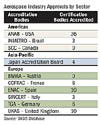
The aerospace industry wasn't the first to develop its own ISO 9001-based standards, but it may take the prize for implementing the most rigorous process for accreditation and certification to its QMS standards. The process is designed to meet the needs of stakeholders around the world. It depends on a level of oversight crucial to an industry where safety and reliability are essential.
AS9100 (revision B, the latest version, was issued in June 2005) is based on ISO 9001: 2000, but includes additions and clarifications that underscore the aerospace industry's concern with safety, reliability and maintenance. AS9100 outlines industry-specific expectations based on best practices, some of which are codified in standards issued by SAE and its global counterparts and referenced in AS9100.
The Americas Aerospace Quality Group (AAQG) and the International Aerospace Quality Group (IAQG) developed AS9100 and several related aerospace standards in a global effort to harmonize industry requirements. Beyond writing the standards, the members of AAQG and IAQG are involved in oversight of certifications and approvals related to these industry standards.
Oversight at All Levels
Approval to operate as an accreditation body (AB) for the aerospace industry must be granted by the appropriate industry oversight body. In North, South and Central America, AAQG provides oversight and recognizes three ABs: INMETRO in Brazil, the Standards Council of Canada, and the ANSI-ASQ National Accreditation Board (ANAB) in the United States.The aerospace industry invited ANAB to participate in development of AS9100 and its precursor, AS9000. In conjunction with ANAB-then the Registrar Accreditation Board-AAQG established a process and requirements for registrars that assess industry suppliers and issue AS certificates when warranted. The process was based, in part, on benchmarking against other industry-specific standards in an effort to benefit from what had been learned and avoid potential pitfalls.
The process includes training and practical experience to ensure auditors and registrars are competent and experienced in the industry. AAQG created the Registrar Management Committee (RMC) to oversee approvals in the Americas. The RMC also annually audits the performance of ANAB and other sector ABs.
The process is defined in SAE's Aerospace Standard 9104, Requirements for Aerospace Quality Management Systems Certification/Registration Programs, which details operation and responsibilities of all parties involved in the approval process. Requirements for certification of an aerospace manufacturer's Quality Management System (QMS) to AS9100 are also contained in AS9104, which was developed by IAQG.
These requirements are applied by ANAB and other ABs. ANAB piloted the industry's accreditation process (to AS9000) in the United States, but development during that period was very much an international activity. Lessons learned during the pilot were included in developing AS9100.

Requirements, Requirements
A registrar must be accredited for ISO 9001 for at least a year before it's eligible for aerospace accreditation. In addition, the registrar must have a process for qualifying aerospace auditors based on industry requirements and have at least one industry-approved aerospace auditor before it can become accredited.To become an aerospace experience auditor (AEA), an auditor must have worked for four of the previous 10 years in the aerospace industry in a function relating to aircraft or spacecraft quality management systems. An auditor with less than four years of aerospace experience can qualify by taking specialized training and being witnessed.
ANAB requires that its accreditation auditors-who assess the registrar for accreditation and re-accreditation-hold the same credentials the registrar's auditors are required to have. As a result, ANAB's group of aerospace auditors include a former Federal Aviation Administration (FAA) inspector and a former aerospace OEM site representative.
While an AB or a personnel certification body must vet each auditor's credentials, the AEA designation cannot be granted until an auditor's application is approved by the appropriate aerospace oversight group-again, the RMC in the Americas. An industry oversight group must also approve any registrar application before ANAB or another AB can grant aerospace accreditation.
Industry oversight continues when an AB audits a registrar. OEM representatives observe both office and witness audits of any registrar seeking accreditation or re-accreditation. About 15 OEM representatives handle this responsibility in the Americas, and ANAB meets with the RMC each September to line up OEM representatives for audits scheduled for the coming year. The goal is 100% industry participation in audits.
The presence of an industry representative brings added expertise to audits. During both office and witness audits, the aerospace representative and auditor concentrate on contractual requirements as well as industry requirements. A specifically formatted report summarizing auditor results must be submitted to the RMC after each audit.
Because the supplier, registrar and AB are all part of the aerospace quality supplier assurance process, all are subject to audit by regulatory or other authorities at any time. This is a key distinction that sets aerospace certification apart from other certifications. The industry remains in control because it is required to do so by regulatory authorities-in the United States, by the FAA.
For a supplier seeking certification, the rigors of the process go beyond that of an ISO 9001 audit, as the registrar additionally audits to the aerospace-specific requirements of AS9100. For every nonconformance issued, the client is required to conduct a root-cause analysis, which must be accepted by the registrar before the nonconformance can be closed. And each registrar enters audit results in a database where they are available for use by the industry in making sourcing decisions.
An OASIS for Stakeholders
The rigors of the entire aerospace process are made manifest in the OASIS database. Launched in July 2003, OASIS is available to all stakeholders, including OEMs, suppliers, customers, national aviation authorities, national defense and space agencies, ABs, registrars and aerospace auditors. It provides essential information on each part of the QMS assessment process. The level of access to information in the database depends on the role or privileges of the user. Approved ABs are entered into the database by the sectors: Americas, Asia-Pacific and Europe. Registrars and auditors are entered by the ABs and assessments of certified organizations are entered by the registrar issuing the certificate.Without the OASIS database, OEMs would have to independently verify each auditor, certification body and assessment result. Providing independent verification of the status of certification enables global acceptance of a single assessment, eliminating the need for multiple audits by different stakeholders.
The benefits of the database are numerous. Customers, OEMs and suppliers get complete and timely information on aerospace QMS approvals. OASIS provides current information on ABs, registrars and auditors, indicating who is approved and for what. And national aviation authorities, departments of defense and space agencies have access to complete oversight information from a single source.
An AS9100-certified organization does not have the option of being excluded from the OASIS database.
Safeguarding the Process
Since December 2002, ANAB devoted 11 issues of "Heads Up"-a newsletter issued intermittently to quickly convey pertinent information to accredited registrars and accreditation auditors-to aerospace industry concerns, including a summary of AAQG-RMC lessons learned in Heads Up 31.A more formal safeguard is the complaint process detailed in AS9104, which follows the common formula of lodging a complaint at the appropriate level and elevating it as needed. A complaint about a certified organization first should be taken up with that organization, with the potential to elevate the complaint as needed to the registrar, the AB, and ultimately the RMC. The process works, and ANAB has suspended a registrar following investigation of a complaint. Suspension has also resulted from ANAB's own oversight. To date, ANAB has not withdrawn an AS accreditation, although a few registrars have voluntarily withdrawn.
The unique requirements of the aerospace industry for added levels of oversight have resulted in rigorous processes supporting AS9100. These processes and the OASIS database produce everyday, real-life benefits. With suppliers undergoing fewer verification audits and their customers reporting improved supplier performance, the aerospace industry is moving more efficiently and profitably into the future.
Sidebar: Quality Tech tips
- AS9100 (revision B, the latest version, was issued in June 2005) is based on ISO 9001: 2000, but includes additions and clarifications that underscore the aerospace industry's concern with safety, reliability and maintenance.
- AS9100 outlines industry-specific expectations based on best practices, some of which are codified in standards issued by SAE and its global counterparts and referenced in AS9100.
- Approval to operate as an accreditation body for the aerospace industry must be granted by the appropriate industry oversight body. In the United States, AAQG provides oversight and recognizes the ANSI-ASQ National Accreditation Board (ANAB).
Source: Richard van Binsbergen